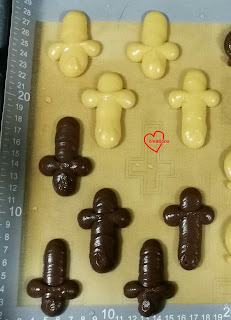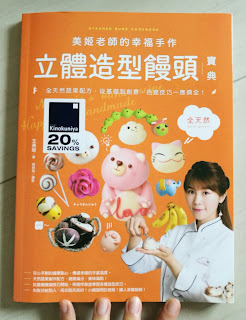Those of you who followed my baking journey right from the beginning will know that my first love in the Creative Baking arena is not chiffon cakes nor macarons, but steamed buns. I used to make it for my kids who had fun eating them.
This is an impromptu late night "bake" that came about because my hands were itching to try out a recipe and technique :)
Cute bear and cat plain steamed milk buns!
My family decided to go to Kinokuniya recently as the store was having a 20% discount on the books. This book caught my eye so I bought it.
Those of you who love cute steamed buns and are able to read traditional Chinese (unfortunately many great Chinese recipe books are not written in simplified Chinese), go grab a copy now! Highly recommended! It covers the basic techniques, the use of natural ingredients such as food powders, fresh fruit and vegetable puree to colour and flavour the buns, and have lots of wonderful project ideas from simple to challenging.
I was really intrigued by the recipe and technique as it is so different from what I had been doing in the past. Most bao or steamed bun recipes I find from the internet use low protein flour, a combination of yeast and baking powder as raising agent and require two rounds of proofing. I always used vegetable shortening as the fat in steamed buns as I found that the texture is softer than if I used vegetable oil. But teacher Meiji uses olive oil as the base oil in her recipes.
Her ingredient list for basic milk steamed bun recipe which I adapted from is like this:
Teacher Meiji's steamed milk bun recipe
Ingredients (makes about 8-9 plain buns):
155ml milk
3g (about 1tsp) instant yeast
30g caster sugar
300g plain flour (medium protein flour)
8ml olive oil
I found that the liquid component in her recipe is not enough for the plain flour I am using and the resulting dough is rather stiff and dry. Do adjust the flour and liquid quantities to suit your flour. I also used slightly less yeast as Singapore is really warm and I am not so fast in shaping.
This is my adapted recipe which is half the original for my late night trial "bake".
Adapted steamed milk bun recipe
Ingredients (makes about 4-5 plain buns):
85g cold milk (cold because Singapore is very warm and you don't want the yeast activity to speed up too fast)
1g (1/3 tsp) instant yeast
15g caster sugar
A pinch of salt
150g plain flour
5g coconut oil (or any other vegetable oil)
A bit of water for sprinkling and dabbing
Steps:
1. Combine milk, sugar, salt and instant yeast in a mixing bowl. Add flour and oil.
2. Use a wooden spoon or spatula to mix together the ingredients until no more liquid is seen and the flour mixture has the appearance of snowflake pieces.
3. Transfer the dough to work surface and knead for about 10-15 minutes, until the dough is smooth. You may use a stand mixer to do this but I personally prefer kneading by hand. Do use your body weight to knead and try not to tear the dough while kneading it so that you do not tear the gluten strands that are being formed.
4. Divide the dough to balls of 45-50g (for the heads) and some dough left for the ears and snout. Do keep any unworked dough covered to prevent it from drying out. Teacher Meiji uses thick plastic sheets (not cling wrap) to loosely cover the resting dough. Plastic bags for food that are sold at supermarkets are what she recommends.
5. Shape the dough into round balls for the head. Teacher Meiji did a very detailed step by step pictorial guide on how to do this. I didn't take photos of myself doing this part and it's best explained using pictures instead of words so I have put up pictures from her book here below (please read the book if you can!):
I hope I translate it well enough for those of you who can't read Chinese 😅. First roll each ball of dough into a long rope. Fold into thirds and roll into long rope again. Repeat this until all the trapped air bubbles has been expelled out.
Roll the rope like a snail and then press it flat.
Gather the dough around the sides of the flattened dough and press it into the center. The surrounding and bottom surfaces of the dough should appear smooth.
Turn the ball over with seam side down. Roll the ball of dough in circular motion with your hand cupping around it on the work surface. Add a few drops of water on work surface and continue to roll the dough on the surface to seal the seam.
Finally, place your hands, one on each side of the ball of dough and press the dough while moving your hands in opposite directions. This is to make the dough taller. Rationale that teacher mentions is, the dough will flatten out during proofing.
6. For the bear and cat heads, I place the shaped round or roughly circular dough onto pieces of parchment paper. I shape small pieces of dough into shape of the ears and snout. The pieces were stuck on by first brushing a bit of water on the surface and sticking the pieces together. I used to pinch the parts together or use a toothpick to press the joining parts together in the past so this is something new to me.
7. Place the shaped buns in steaming basket and use 40℃ steam to proof the dough. I know this is kind of hard to estimate. Teacher recommends placing 2 rice cups of water into electric cooker and turn the switch on for a minute to create this effect. Many of us may not have this available at home. I proofed using two methods. One, I used my electric steamer switched on for a minute. I placed a towel over the lid to prevent any water from dripping onto the steaming plate. Two, and probably a more traditional one, is to fill the wok as I normally would for steaming dishes and turn the heat on for about a minute or two and place my hand over the surface. Once I can feel some warm steam rising up. I turn off the heat, place the steaming basket with the wooden cover on into the wok. Cover the wok with the lid. Once the dough has increased by 1.5x, the buns are ready for steaming. Teacher mentioned a very useful tip of measuring the bun size with a ruler before proofing so that you have a better gauge of how much is 1.5x bigger. It took me about 40 minutes of proofing to get to that size.
8. Steam for about 18 minutes. Turn off the heat and wait for 5 minutes before opening the cover of the wok or electric steamer.
9. Immediately transfer to cooling rack to cool completely. To store, individually wrap the buns in plastic and store in fridge or freezer. Resteam when you want to eat.
Freshly steamed bun
Close up view of the insides
I could do with some improvement for the technique but so glad to have learnt much :). Hubby gave a thumbs up for the taste and texture and said it tastes better than my previous recipes which tends to have a little yeasty smell. The texture is firmer than my softer buns that use low protein flour but not in an unpleasant way.
Teacher Meiji uses dough (or painted on powders mixed in water to the dough before steaming) to include all detailed features. Since this is my first trial using her recipe, I decided to keep things simple and added the details using edible marker after the buns have cooled completely. Please store these in airtight container without anything touching the ink surface. Or the ink may smudge.
Feel free to wrap any filling of your choice inside if you don't like plain buns. Use 35g of dough and 15g of filling as suggested by teacher Meiji.
I stored a couple of buns at room temperature in an airtight container for one and a half days (no filling inside so it's ok to store at room temperature) and resteamed the buns for 10 minutes. To my pleasant surprise, the ink didn't run at all!
Such a cheery greeting for breakfast in the morning!
The insides remain fluffy and soft but firmer than if low protein flour was used. But it's still almost the same as freshly steamed. Just perhaps a teeny bit firmer.
Fluffy steamed bun!
I got the kids to taste test this time and they gave a thumbs up too!
Do give this recipe a try if you would like homemade steamed buns! This single proofing method is also much faster than my previous ones that require two rounds of proofing.
Update: some ladies have been very kind to alert me to teacher Meiji's
Youtube video. Please watch it if you are able to understand Mandarin.
With love,
Phay Shing























































